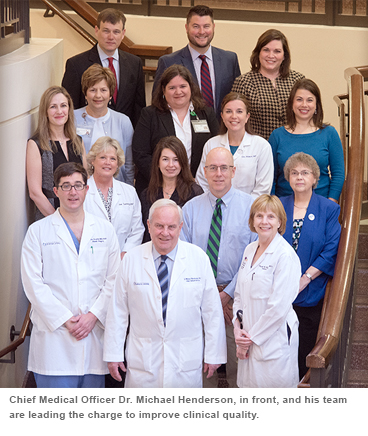Reflecting on Our Quality Journey
Last year we made progress in each of these areas.
Under leadership, we instituted monthly Leadership Rounds, in which approximately 100 senior administrators fan out through the hospitals and clinics to interact directly with clinical staff and patients. The rounds give leaders a better handle on what issues front-line staff are dealing with and give the staff the understanding that their concerns matter.
 We also initiated quarterly meetings with leaders of clinical departments and nursing units, reviewing and taking ownership of quality data pertinent to their respective areas. And Dr. Michael Henderson, chief medical officer, began regular reports on clinical quality to our board of trustees, reflecting leadership engagement in quality improvement at the highest level of the organization.
We also initiated quarterly meetings with leaders of clinical departments and nursing units, reviewing and taking ownership of quality data pertinent to their respective areas. And Dr. Michael Henderson, chief medical officer, began regular reports on clinical quality to our board of trustees, reflecting leadership engagement in quality improvement at the highest level of the organization.
Under culture, more than 90 percent of our workforce completed the error prevention training course. Seventy-four percent took the employee engagement and culture of safety surveys. We deployed a second intranet site dedicated to the clinical enterprise that features the most current quality measures down to the provider level. And we turned up the volume on conversations about clinical quality in our campus media, including in VC Notes.
Under performance improvement in 2016, we established quality goals and set specific targets. We made these data, updated monthly, available to all on the clinical intranet. For each goal, a team led by physicians or nurses was assigned to drive improvements. In some areas - patient safety indicators, hand hygiene, adverse event reporting and patient satisfaction - we've seen marked improvement. In others - hospital-acquired infections and 30-day re-admission - progress has been slower or inconsistent. But for every measure, we've deployed improved systems to capture reliable data, analyze performance gaps, and set the stage for further improvement.
Now, we've turned the page to 2017. Our task is to sustain and build upon the foundational work and progress we established last year.
- We'll extend engagement beyond senior leaders into middle management and service line leaders. We want to empower our staff at all levels to understand and embrace our quality journey and become agents of change to drive improvement.
- We'll expand and enrich the conversation about quality with new features on the clinical intranet and new tools to support interactive communication.
- We'll intensify the focus on our two biggest assets that drive culture change: our employees and our patients. We'll continue to improve responsiveness to patient complaints and deploy new strategies to enhance completion of patient satisfaction surveys. We'll involve patients and their families in advisory councils and foster shared decision-making with the clinical team. With employees, we're taking a deep dive into last year's engagement survey with an eye to improving communication, respect, professional development, and reward and recognition.
- We'll have similar goals to last year for performance improvement, but will establish new baselines and targets. We'll expand our quality efforts to the ambulatory setting with a new scorecard, goals and targets. And we will continue to move toward greater transparency in sharing these data with the public.
As I've said a number of times in this forum and elsewhere, clinical quality improvement is our number one strategic priority. The quality of care we provide factors into the degree to which patients trust us with their health care, how much we are reimbursed by insurers, and the quality of our educational programs. A quality improvement mindset is something we all must internalize and live into as part of our daily walk.
I consider what we've done in the last 12 to 18 months a very good beginning. I congratulate our quality leadership team for getting us organized. But the real stars of this show are each and every one of you. And it's your ownership of this quality imperative that will fuel our progress toward A Healthier Mississippi.



